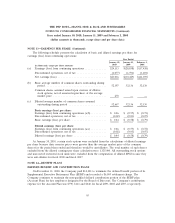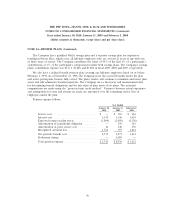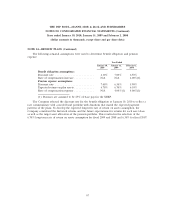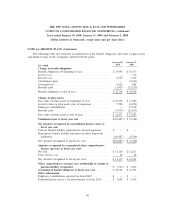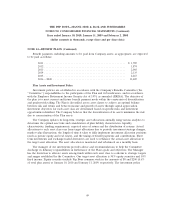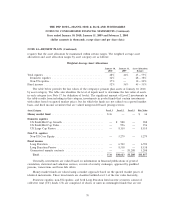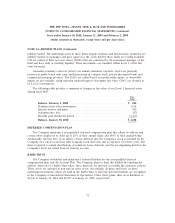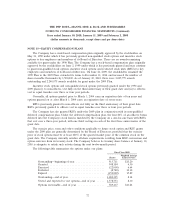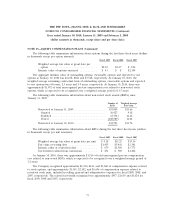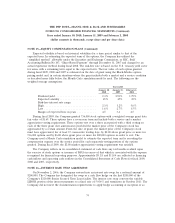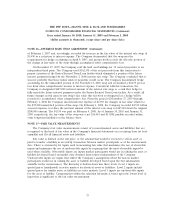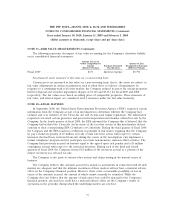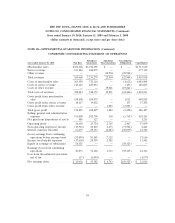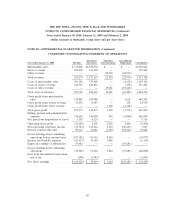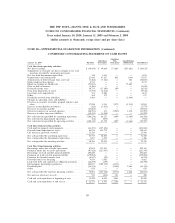Pep Boys 2009 Annual Report Download - page 133
Download and view the complete annual report
Please find page 133 of the 2009 Pep Boys annual report below. You can navigate through the pages in the report by either clicking on the pages listed below, or by using the keyword search tool below to find specific information within the annual report.THE PEP BOYS—MANNY, MOE & JACK AND SUBSIDIARIES
NOTES TO CONSOLIDATED FINANCIAL STATEMENTS (Continued)
Years ended January 30, 2010, January 31, 2009 and February 2, 2008
(dollar amounts in thousands, except share and per share data)
NOTE 16—INTEREST RATE SWAP AGREEMENT (Continued)
of February 3, 2007 and, accordingly, recorded the increase in the fair value of the interest rate swap of
$1,490 as a reduction to interest expense. The Company documented that the swap met the
requirements for hedge accounting on April 9, 2007, and prospectively records the effective portion of
the change in fair value of the swap through accumulated other comprehensive loss.
On November 27, 2007, the Company sold the land and buildings for 34 owned properties to an
independent third party. The Company used $162,558 of the net proceeds from this transaction to
prepay a portion of the Senior Secured Term Loan facility which eliminated a portion of the future
interest payments hedged by the November 2, 2006 interest rate swap. The Company concluded that it
was not probable that those future interest payments would occur. The Company discontinued hedge
accounting for the unmatched portion of the November 2, 2006 swap and reclassified a $2,259 pre-tax
loss from other comprehensive income to interest expense. Concurrent with this transaction, the
Company re-designated $145,000 notional amount of the interest rate swap as a cash flow hedge to
fully match the future interest payments under the Senior Secured Term Loan facility. As a result, all
future changes in this interest rate swap’s fair value that has been re-designated as a hedge will be
recorded to accumulated other comprehensive loss. From the period of November 27, 2007 through
February 1, 2008 the Company incurred interest expense of $1,907 for changes in fair value related to
the $55,000 unmatched portion of this swap. On February 1, 2008, the Company recorded $4,539 within
accrued expenses to reduce the notional amount of the interest rate swap to $145,000 from the original
$200,000 amount. The $4,539 was paid on February 4, 2008. As of January 30, 2010 and January 31,
2009, respectively, the fair value of the swap was a net $16,401 and $15,808 payable recorded within
other long-term liabilities on the balance sheet.
NOTE 17—FAIR VALUE MEASUREMENTS
The Company’s fair value measurements consist of (a) non-financial assets and liabilities that are
recognized or disclosed at fair value in the Company’s financial statements on a recurring basis (at least
annually) and (b) all financial assets and liabilities.
Fair value is defined as the exit price, or the amount that would be received to sell an asset or
paid to transfer a liability in an orderly transaction between market participants as of the measurement
date. There is a hierarchy for inputs used in measuring fair value that maximizes the use of observable
inputs and minimizes the use of unobservable inputs by requiring that the most observable inputs be
used when available. Observable inputs are inputs market participants would use in valuing the asset or
liability developed based on market data obtained from sources independent of the Company.
Unobservable inputs are inputs that reflect the Company’s assumptions about the factors market
participants would use in valuing the asset or liability developed based upon the best information
available in the circumstances. The hierarchy is broken down into three levels. Level 1 inputs are
quoted prices (unadjusted) in active markets for identical assets or liabilities. Level 2 inputs include
quoted prices for similar assets or liabilities in active markets. Level 3 inputs are unobservable inputs
for the asset or liability. Categorization within the valuation hierarchy is based upon the lowest level of
input that is significant to the fair value measurement.
75


